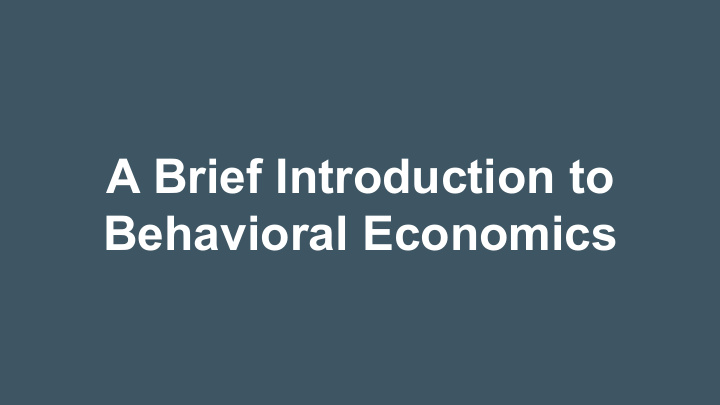



A Brief Introduction to Behavioral Economics
A field that… • Integrates behavioral sciences (psychology, sociology) into analysis of human decision-making. • Assumes decision-making behavior can be irrational, too, not only logical (distinct from classical economics). • Asserts decision-making is influenced by context, and even by the way information is presented. Behavioral economists attempt to understand why.
Why is it useful? 1. Gaining insights about human behavior; 2. Using those insights to develop change strategies; and 3. Implementing those strategies to change feelings and behaviors among actors in a system.
MINDSPACE Framework MINDSPACE Framework Messenger - We are heavily influenced by who communicates information to us. Incentives - Our response to incentives is shaped by predictable mental shortcuts such as reference points, aversion to losses, and overweighting of small probabilities. Norms - We are strongly influenced by what others do. Defaults - We “go with the flow” of pre-set options. Salience - Our attention is drawn to what is novel and also to what seems relevant to us. Priming - We are often influenced by subconscious cues. Affect - Our emotional associations can powerfully shape our actions. Commitments - We seek to be consistent with our public promises, and to reciprocate acts. Ego - We act in ways that make us feel better about ourselves.
EAST Framework EAST Framework Make it Easy - Harness the power of defaults, reduce the ‘hassle factor’, simplify messages. Make it Attractive - Draw people toward preferred behaviors, design rewards and sanctions to maximize effect. Make it Social - Show people the norm, use the power of networks to encourage and support, encourage people to make a commitment. Make it Timely - Prompt people when they are most likely to be receptive, consider immediate costs and benefits, help people plan their response.
The Behavior Change Project • 12 case studies • Multi-disciplinary, cross-sector work • Examination of the work through a behavioral economics lens • Distillation of what’s most effective for nudging human behavior change, with an eye toward transferable lessons for cities
“Big Ideas” from the Behavior Change Project Case Studies 1. Relationships, and the messengers who leverage them, are integral to advancing change that will scale impact at a systems level. 2. The complexity of shifting culture requires managing many change strategies in parallel . 3. Shifting behavior requires a team to understand and engage its target audience intimately .
Recommend
More recommend